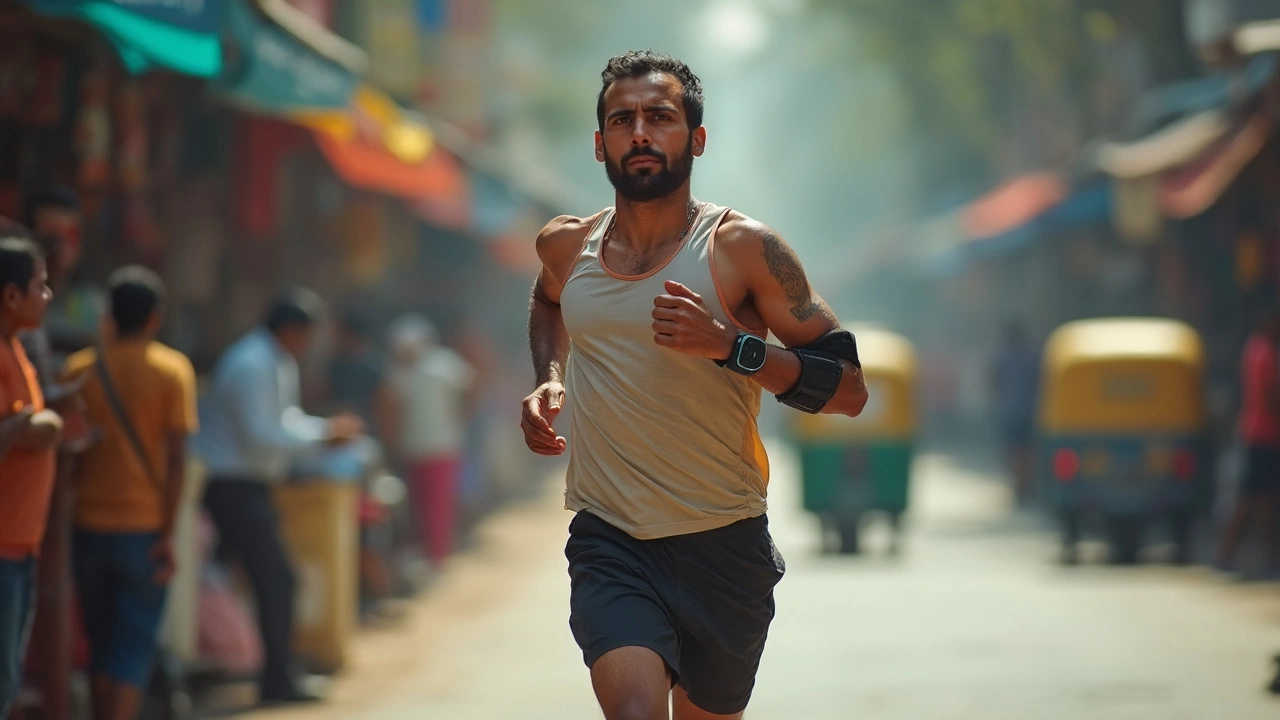Shooting for a 35-minute 5K? You’re not alone, and honestly, that’s a way more common goal than you might think. For a lot of runners, especially if you’re just getting started or coming back after a long break, it’s a totally solid benchmark. Chances are, you’ve seen finishers faster and slower at just about any local race—it’s all about finding your own pace and progress.
The thing is, 35 minutes for a 5K means you’re holding about 11 minutes, 15 seconds per mile. Sounds a bit intimidating if you haven’t checked your pace lately, but broken down, it’s a mix of running and brisk walking for many people. If you stick with a training plan, most healthy adults can absolutely get there—no running background required.
Here’s what matters most: steady, consistent effort beats going hard just once or twice a week. Start by figuring out your current level—maybe walk a bit and jog a minute at a time if you’re totally new. Don’t be afraid to alternate running with walking. It’s not cheating, it’s part of the process.
- Is 35 Minutes a Realistic 5K Goal?
- What Pace Do You Need for 35 Minutes?
- Simple Training Plans for Every Starting Point
- Common Mistakes and How to Avoid Them
- Gear and Basics: What Really Matters?
- When Race Day Arrives: Last-Minute Tips
Is 35 Minutes a Realistic 5K Goal?
If you’ve ever looked at race results online, you already know that hundreds of people finish their local 5K somewhere around that 35-minute mark. It’s not the slowest, and it’s far from elite, but it’s a legit, reachable time for a huge chunk of runners. According to recent U.S. running stats, the average 5K finish time for adults lands between 32 and 38 minutes—right in the ballpark.
This is especially true if you’re new to running or you haven’t run since high school gym class. Setting a goal like this isn’t about impressing anyone; it’s about giving yourself a challenge that won’t destroy your knees, and that you can hit with a few months of smart training. Plus, most charity and fun run 5Ks welcome walkers and joggers, so you’ll be surrounded by tons of people with the same vibe.
A run 5K goal at this pace is realistic if you can walk briskly for 30 to 40 minutes already. Even if you’re still working up to that, it’s doable—just make your biggest priority sticking to regular workouts, and don’t sweat your speed at first. Motivation goes a long way, and seeing progress each week is way more important than a scary number on your watch.
Here’s something you won’t hear enough: life happens. Some weeks will be tough, you may miss a few sessions, or the weather will go bananas. The good news is, the 35-minute mark gives you wiggle room. You’re not chasing a unicorn—just showing up, moving forward, and pushing a little bit further each time.
What Pace Do You Need for 35 Minutes?
If you're aiming for a 35-minute finish in a 5K, it's all about breaking down that time goal into simple, doable chunks. The magic number you want is 11 minutes and 16 seconds per mile—more or less. That’s the average pace you’ll need to nail if you want to close out those 3.1 miles right at 35 minutes.
Here’s how it falls out, mile by mile:
| Distance | Target Cumulative Time | Pace per Segment |
|---|---|---|
| 1 mile | 11:16 | 11:16 |
| 2 miles | 22:32 | 11:16 |
| 3 miles | 33:48 | 11:16 |
| 5K / 3.1 miles | 35:00 | ~11:16 |
That’s not Olympic speed, but it does mean keeping a steady jog that doesn’t turn into a power walk. If you’ve ever used a treadmill at the gym, setting it to 5.3 mph hits that exact number. Not fast, but you need to keep moving forward the whole way.
- run 5K tip: If pacing sounds tricky, use running apps (like Strava or MapMyRun) or a simple digital watch to check your time after each mile marker.
- Splitting the race into three chunks can also help: Just focus on making it to each mile marker close to 11:16, then take a mental reset.
- Try doing some of your training exactly at that 11:16/mile pace, so it doesn’t surprise you on the big day.
If you’re new to timing yourself, go for a few test runs on a flat path or loop where you know the distance. Don’t stress about being a few seconds off—just keep your eyes on that consistent pace, and you’ll set yourself up for success on race day.
Simple Training Plans for Every Starting Point
Alright, let’s keep it straightforward. Whether you’re brand new to running or have a few miles under your belt, hitting a run 5K in 35 minutes doesn’t call for fancy tricks. It just takes a plan that matches where you’re at.
Top coaches agree: consistency wins over intensity, especially for beginners. According to the Mayo Clinic, “Gradual progress helps prevent injuries and builds real endurance.” That means don’t worry about speed right away—just focus on getting comfortable moving for longer stretches.
“Anyone can train to finish a 5K, starting with short intervals of running and walking. The key is building time on your feet, not killing yourself with sprints,” says Jeff Galloway, a former Olympian and running coach.
So, how do you build a routine? Here’s a simple breakdown by starting level:
- Total Beginner: Start with 20-30 minutes, three days a week. Walk for 2 minutes, jog for 1 minute. Repeat until time is up. Every week, jog a little more and walk a little less.
- Intermittent Exerciser: Try 3-4 sessions a week. Alternate running for 2-4 minutes with 1-2 minutes walking. Gradually lengthen your running intervals.
- Returning Runner: Aim for 4 short runs weekly. Each session, hold a moderate, steady pace for as long as you can, then walk. Work your way up to running all 5K distance, no pauses.
Check out this table for a quick comparison:
| Level | Weekly Sessions | Run/Walk Breakdown | Expected Progress (Weeks) |
|---|---|---|---|
| Total Beginner | 3 | 1 min run / 2 min walk | 6–8 |
| Intermittent Exerciser | 3–4 | 2–4 min run / 1–2 min walk | 4–6 |
| Returning Runner | 4 | Continuous running, with walking as needed | 3–5 |
Don’t skip strength work. Once or twice a week, add basic moves like squats, lunges, and planks. Strong legs help you run longer and avoid injuries.
Last tip: listen to your body. If you need an extra rest day, take it. Your muscles actually get stronger during downtime, not during the workout itself.

Common Mistakes and How to Avoid Them
If you’re working toward running a 5K in 35 minutes, there are a few classic mistakes that can sneak up and kill your momentum. Let’s talk about the big ones—and what to do differently.
- Starting Too Fast: This is the king of rookie errors. You feel excited, adrenaline’s pumping, and you take off way faster than your body can handle for three miles. The crash comes hard in mile two. Instead, aim for steady splits or start a little slower and build up speed later if you feel good.
- Skipping Rest Days: More running isn’t always better. Muscles repair and get stronger on your days off. Ignoring recovery often leads to nagging pains or even legit injuries like shin splints. Listen to your body.
- Missing Warm-Ups: Jumping right into a fast pace from a cold start is asking for tight calves or pulled hamstrings. Get in a 5-10 minute walk or slow jog before your main effort. Throw in a couple of quick stretches and you’ll notice the difference.
- Wearing the Wrong Shoes: Worn-out or poor-fit shoes cause blisters, sore feet, and knee pain. Always buy shoes that actually fit your running style, and replace them every 300-400 miles.
- Neglecting Hydration: Even slight dehydration drags down your performance. If you’re thirsty before you start, it’s already too late. Sip water regularly, especially in hot weather.
- Training Too Hard, Too Soon: Trying to build speed or distance too fast can lead to overuse injuries. Boost your weekly mileage by no more than 10% from one week to the next.
Here’s how some common pitfalls stack up among beginner runners:
| Mistake | % of Beginners Affected |
|---|---|
| Starting Too Fast | 64% |
| Skipping Rest Days | 47% |
| Improper Hydration | 39% |
| Wrong Shoe Choice | 35% |
| Missing Warm-Ups | 33% |
Don't beat yourself up if you slip into one of these traps; it happens to loads of runners, even folks training for marathons. Just course-correct and keep moving forward. Small changes make a big difference over a few weeks. Trust the process, take care of your body, and you’ll be a whole lot closer to that 35-minute finish.
Gear and Basics: What Really Matters?
You don’t need a closet full of gadgets to crush a 5K in 35 minutes. In fact, way too many beginners get bogged down buying gear that barely matters for this distance. Here’s the real deal of what actually supports your run, helps you avoid injury, and keeps things simple.
The single most important investment is the right pair of running shoes. They should fit well, feel comfortable right away, and match your foot type—some folks need a little extra support, some don’t. Big name brands like Brooks, New Balance, Asics, and Nike each make beginner-friendly shoes under $130. Don’t stress about top-end. Focus on fit. A 2022 Runner’s World survey found 79% of runners said comfort was their top priority over style or even durability.
"You don’t have to spend a lot or get every gadget. The right shoes and clothes are all you honestly need." — Hal Higdon, legendary running coach
Beyond shoes, shirts and shorts that wick away sweat will keep you from chafing and help you feel less weighed down—especially on warm days. Cotton tends to hold moisture, which gets heavy and uncomfortable fast.
- run 5K tip: Save smartwatches and heart rate monitors for later. Most beginners get more value from listening to their bodies than parsing numbers.
- Add socks without bulky seams to avoid blisters.
- If you run outside in summer, use sunscreen. In winter, layer up but skip heavy coats since you’ll warm up quickly after the first mile.
When it comes to tracking time or distance, your smartphone’s timer with free apps like Strava or MapMyRun is plenty for most folks just starting out.
| Gear Type | Must-Have? | Beginner Tip |
|---|---|---|
| Running Shoes | Absolutely | Go to a real running store for a fit check |
| Moisture-Wicking Shirt/Shorts | Very Helpful | Skip cotton, go synthetic or blends |
| Tech Apps/Watch | Optional | Use your phone and free apps if curious |
| Water Bottle | For Hot Days | Hydrate before and after, not just during |
| Hat/Sunscreen | Weather Dependent | Essential for sun, skip for night runs |
Bottom line: focus on what keeps you comfortable and motivated. Don’t let gear decisions delay you from getting out the door. Use what works and ignore the hype. Running 5K isn’t about stockpiling brand names—it’s about building habits that last.
When Race Day Arrives: Last-Minute Tips
Race day comes with nerves—everybody gets them, even the folks who look super confident at the start line. What you do in the 24 hours before the event can actually make a real difference to your run 5K experience and your actual time.
Let’s start with your dinner the night before. Stick with familiar foods—nothing too greasy or rich. Most runners do best with a mix of carbs and a bit of protein, like chicken and rice or pasta with veggies. Hydration is simple: drink water regularly but don’t overdo it right before bed.
Morning of the race? Eat something light an hour or two beforehand—a banana and toast work well. Stay away from anything you’ve never tried before a run to avoid mid-race surprises.
- Pin your race bib on your shirt in advance. It saves panicking later.
- Lay out your shoes, socks, and comfy running gear the night before. Double-check the weather—nothing messes up a run like surprise rain or a heatwave.
- Arrive early. Aim for at least 45 minutes before the start gun. That gives you time to check in, use the restroom, and warm up.
For warming up, walk or jog easy for 5-10 minutes, then toss in a few short, gentle pick-ups if you’re feeling good. No need to exhaust yourself—save the energy for the real thing.
Pacing is where most people blow it. Don’t sprint off at the horn. Stick to your planned pace for the first mile, then see how you feel. There are tons of 5K races where half the field starts too fast and struggles by the halfway mark. If you’ve practiced at a steady pace, trust that feeling and hang on.
Quick stats: Here’s what 5K pacing looks like for a 35-minute finish—if you stay near these splits, you’ll hit your goal.
| Kilometer | Mile | Target Cumulative Time |
|---|---|---|
| 1K | 0.62 mi | 7:00 min |
| 2K | 1.24 mi | 14:00 min |
| 3K | 1.86 mi | 21:00 min |
| 4K | 2.49 mi | 28:00 min |
| 5K | 3.1 mi | 35:00 min |
Last tip—don’t obsess over your watch every two seconds. Glance at it after each mile marker, but focus on staying relaxed and moving forward. You’d be surprised how many people hit their best results by tuning into how their body feels rather than chasing numbers the whole time.


